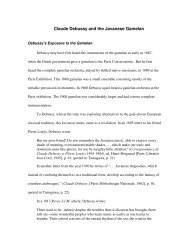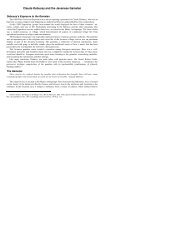Music Preference 1 - Brent Hugh's personal and business web pages
Music Preference 1 - Brent Hugh's personal and business web pages
Music Preference 1 - Brent Hugh's personal and business web pages
Create successful ePaper yourself
Turn your PDF publications into a flip-book with our unique Google optimized e-Paper software.
<strong>Music</strong> <strong>Preference</strong> 11<br />
listening group, <strong>and</strong> no change in the control group. This demonstrates that listening alone can<br />
increase preference but listening combined with increased knowledge increases preference by a<br />
greater degree.<br />
Repeated listening to an individual musical work. Hargreaves (1984, 1986) proposed an<br />
inverted-U theory to explain the relationship between complexity of a musical selection as<br />
perceived by the listener <strong>and</strong> the listener’s response to repeated listening. <strong>Preference</strong> for music<br />
increases with each subsequent hearing until a point of satiation is reached, when preference<br />
begins to decline. <strong>Preference</strong> for both simple music <strong>and</strong> complex music over repeated hearings<br />
describes this inverted-U shape, but the peak of the preference curve will occur sooner with<br />
simple music <strong>and</strong> later with complex music. Hargreaves’s experiments with college students at<br />
least partially confirmed the inverted-U theory, although the effects of repeated listening were<br />
relatively small compared to the overriding effect of the listeners’ musical prejudices. Getz’s<br />
1966 study of seventh graders confirmed both the inverted-U theory <strong>and</strong> the relatively stronger<br />
effect of musical prejudice; Schaffrath' s 1978 study of fifteen-year old students in Germany<br />
confirmed that repeated listening affects aesthetic judgment.<br />
Heyduk (1975) found that the effect of repeated exposure varied, depending on the<br />
relationship between the complexity of the music heard <strong>and</strong> the degree of complexity preferred<br />
by the listener. If the degree of complexity of the musical selection is lower than the listener' s<br />
preferred complexity, repeated listening causes a decrease in preference. If the degree of<br />
complexity of the music is higher than the listener' s preferred complexity, repeated listening<br />
leads to a gradual increase in preference. Hargreaves (1986) explains this difference by<br />
theorizing that listeners are entering the repeated-listening inverted U at different points: on the





